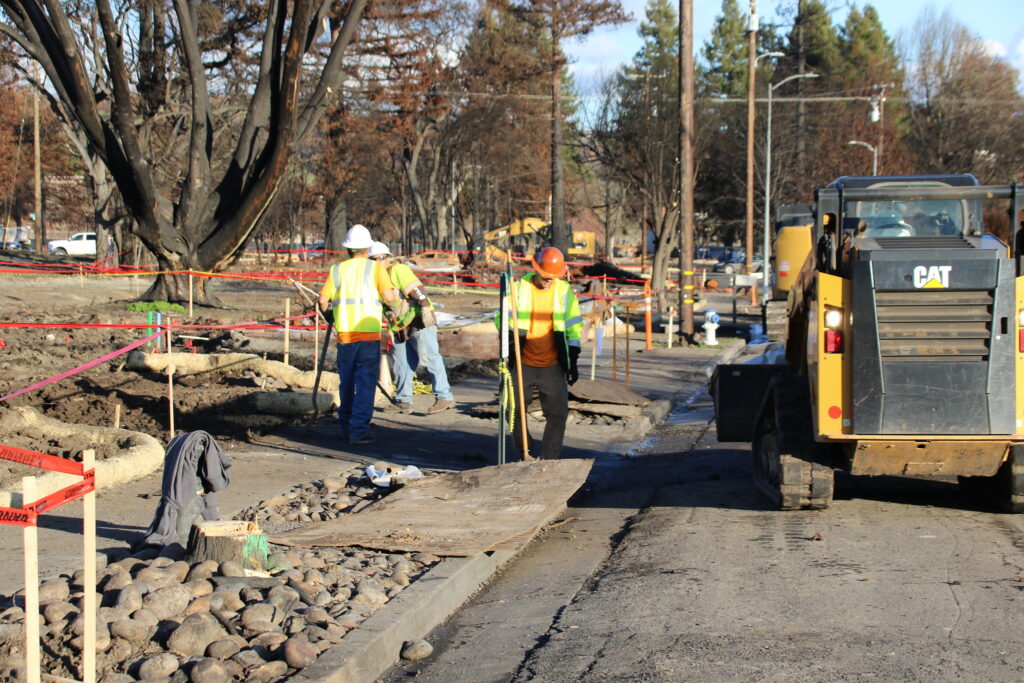NEW BOOK EXCERPT:
‘PROTECTING CITIES FROM WILDFIRES’
Rethinking land use, housing
and rebuilding regulations
by Steven Greenhut | August 15, 2025
This is an excerpt from Greenhut’s new Free Cities Center booklet, “Protecting Cities from Wildfires: Improving California’s Land-Use, Water and Brush-Clearance Strategies.”
After the Los Angeles wildfires began their devastation, Gov. Gavin Newsom on January 12 issued an executive orderthat wisely exempted rebuilding efforts in the devastated areas from key state environmental regulations.
The two main provisions are unobjectionable. The first would “Suspend CEQA [California Environmental Quality Act] review and California Coastal Act permitting for reconstruction of properties substantially damaged or destroyed in recent Southern California wildfires.” The second would “Direct state agencies to identify additional permitting requirements, including provisions of the Building Code that can safely be suspended or streamlined to accelerate rebuilding and make it more affordable.” The fourth, although vague, also is admirable as the governor committed to “working with the Legislature to identify statutory changes that can help expedite rebuilding while enhancing wildfire resilience and safety.”
The order’s third item—“extend protections against price gouging on building materials, storage services, construction and other essential goods and services to Jan. 7, 2026, in Los Angeles County”—is counterproductive. When items are in short supply, allowing prices to fluctuate to reflect their scarcity is the best way to get materials into the disaster zone quickly. Prices will moderate as supplies increase. But, nevertheless, three out of four isn’t bad—especially in an administration not exactly known for its embrace of market economics.
Newsom followed up with a series of orders—good and bad, but mostly good—that expedited debris clearance, fast-tracking government relief and further expediting local regulatory exemptions. “We will not let overly strict regulations get in the way of rebuilding these communities,” he said. “The state stands with its local partners to ensure that we cut red tape and make recovery as easy as possible.” There’s no arguing with his words, although it seems unlikely that they are enough to chip away at years of burgeoning regulatory barriers.
State officials have long known about the impediments placed in the way of housing construction and infrastructure by CEQA and the Coastal Act. The state is in the midst of a housing crisis, as statewide median home prices have soared about $800,000 as of June 2025. Most market-rate developments, which require discretionary governmental approvals, are subject to the long and costly Environmental Impact Report process—and frequently are targeted by CEQA lawsuits.
A private firm had proposed building a water desalination plant at an industrial site in Orange County that would have met the needs of 10% of the county’s residents, but the commission unanimously rejected the projects after years of debate and discussion over fears about its effect on ocean plankton around the intake valves. Newsom supported the project, but alas his commission appointees did not.
Regarding housing, California Democrats have led the charge over several years for various housing bills that have, in a limited manner, streamlined CEQA requirements for housing. Senate Bill 423, signed in 2023, created CEQA exemptions to build housing in cities that comply with the state’s housing mandates—and even applied to cities in the coastal zone. Senate Bills 9 and 10 are other landmark housing laws. SB 9 creates a “by right” housing approval for duplexes in single-family neighborhoods and SB 10 does so for multi-family projects along housing routes. SB 9 is caught up in the courts.


We’re already seeing a battle over what gets built to replace what was destroyed. In his February article for the Free Cities Center, PRI fellow Kerry Jackson fears that Los Angeles officials will be tempted to rebuild the burned-out mostly single-family neighborhoods along the lines of the city’s master plan. That means design standards that “positively transform the urban environment,” and “require careful strategic planning and investment” to create “intelligent urban ecosystems designed for the humans that live there.” In English, it means higher densities.
So far, the approach taken by the city and county seems focused on rebuilding along the “fire-wise” principles that incorporate best practices in wildfire resilience. I braced for the worst when I saw an article in the environmentalist planning publication, Planetizen, which reported on rebuilding resources from the county’s Chief Sustainability Office and its climate resilience officer. But, per the article, the office is mainly concerned about implementing “practices like building hardening and defensible space not only help individual properties but significantly improve neighborhood-scale resilience.”
An article in the left-wing Nation magazine focused on devastation in Altadena in the San Gabriel Valley, a city settled by African Americans who fled the discrimination of the Jim Crow South. To its credit, the publication’s concern—a legitimate one, in my view—was assuring that residents there had the resources and help necessary to rebuild their community in ways that reflected the history of the city. For instance, architects are “compiling a set of plans for the types of houses typically found in Altadena—ranches, Mission style, Craftsman bungalows—and working with other architects (and, ideally, builders) to streamline the design and construction process so that displaced residents can rebuild as quickly and easily as possible.”
That’s great. But there are plenty of reasons to share Jackson’s concern. As Reuters reported in late January, “As Los Angeles recovers from its devastating wildfires, environmental engineers, urban planners and natural disaster experts are casting forward with visions of what could come next for neighborhoods that have been reduced to ash and rubble. Apartment buildings could spring up where strip malls and parking lots once stood, with locals walking to ground-floor shops, offices and cafes, European-style.” The headline calls it a “moonshot moment”—but Los Angeles needs fewer moonshots and more policies that uphold property owners’ rights to rebuild their homes as they please.
So far, most of the re-envisioning talk is just that, talk. Beyond the state exemptions from CEQA and the Coastal Act, the city of Los Angeles has waived a controversial rule that required new construction to be electric-only—overturning a ban on natural-gas appliances. Furthermore, the city is taking a lenient approach toward “non-conforming” structures, thus allowing them to be rebuilt as before as long as they don’t exceed 110% of the pre-existing size. The myriad exemptions give wide latitude for affected homeowners to rebuild, which reduces concerns that planning agencies might use the destruction as an opportunity to force a change local land-use patterns. But we’ll watch and see, especially in light of legislation that would create an agency with the authority to spend state dollars on “affordable housing” projects in fire-damaged areas.
If California is ever going to address its housing shortages, it needs to take lessons from the wildfires and get serious about reforming CEQA. The wildfires reinforced that these regulations are impediments to construction. Four months after the devastation, we’re still not seeing calls for overturning or revising the 1970 law, but lawmakers are going further than before. And Newsom even held up the budget to secure far-reaching CEQA reforms. That’s perhaps one of the few silver linings from the wildfires.
